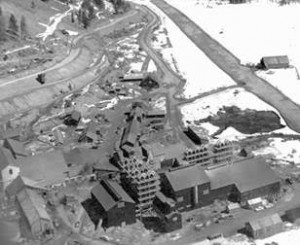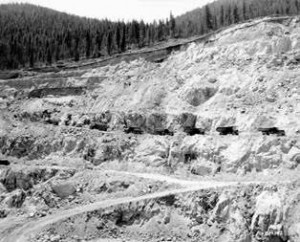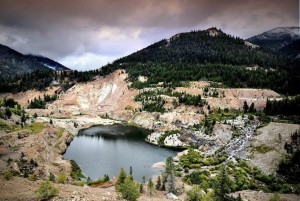Midas Gold is a junior gold explorer that IPO’ed during the summer of 2011 when the gold sector was in a frenzy and investors eagerly bid up gold plays to record valuations. Those days have long since passed; after reaching an all-time high of $4.90/share in January 2012, Midas shares currently sit around .40/share after a brutal 90%+ decline over the past 3 years. The large decline in Midas shares is not unique among the junior mining space, however, Midas’ flagship Stibnite Gold Project in Idaho is quite unique. Stibnite offers an excellent location for mining and a proven resource in addition to an enticing kicker in the form of a sizable presence of the strategic mineral, alimony, at Stibnite. Scott Armstrong sat down with Midas CEO Stephen Quin and got the full scoop on one of the more intriguing long-term plays in the Canadian junior mining space:
Scott Armstrong: It’s a pleasure to be here today and be able to offer our readers insights into an intriguing mineral resource that may be off many people’s radars, can you tell us about Midas Gold and what makes Midas Gold so unique among its junior explorer peers?

Midas Gold Corp CEO Stephen Quin
Stephen Quin: Midas Gold Corp (TSX: MAX) has one of the largest, highest grade open pit gold projects located in a geopolitically safe and mining friendly jurisdiction – the Stibnite Gold Project located in central Idaho, USA. This is a brownfield project, having been extensively mined and disturbed over the past almost 100 years, and integral to the project concept is the restoration of the site, addressing many of the legacy issues left by prior operators.
Scott Armstrong: Where are you at in terms of developing the mine in terms of permitting and financing?
Stephen Quin: Since we went public in July 2011, we put out our first resource estimate, then we put out a preliminary economic assessment with an updated resource estimate and then, in December last year, we put out a pre-feasibility study. All of that has been working forward towards defining the type of project we would like to permit, the project scale, what resources are available, and the economics obviously. But also integrate all the environmental reclamation and remediation of historic disturbance. All of these activities were integrated and came together in the pre-feasibility at the end of last year.
Now what we’re doing is taking that study around to stakeholders. That’s a pretty broad group, we’ve got about 40-50 meetings set up in the first half of this year where we’re meeting with community groups, NGOs, regulators, etc. and explaining what the project is, how we’re incorporating the clean-up of historic disturbance and what we are going to leave behind. Essential is soliciting continued input and we’re going to take that input and integrate it, where possible, into a permit application. The aim would be to advance that permit application during the 2nd half of this year.
Scott Armstrong: We’ve noticed that you’ve added some locals to your board. Is that what has given you confidence in the permitting process going forward?
Stephen Quin: When we were meeting with people after the PEA a couple years ago, some of the feedback we got back was that we had no locals involved. So people were saying “you’re saying you’re going to do all of these things but how do we know? You’re from outside the state and outside the country. How can we have confidence in that?” Obviously the site has been disturbed by prior activities, but we want to make sure that things are being done right going forward. So, we decided to take it a step further by not only inviting two prominent Idaho residents to our board but we also set up a local operating company with a majority of independent local citizens: 5 out of the 6 on the board of the local operating company are independent non-employees, and four are locals so, to a large extent, we have handed the keys to the project over to the locals. This provides a much higher degree of transparency than almost anything else you’ve probably seen in recent times.
Scott Armstrong: Why should investors consider buying shares in Midas Gold? What makes Midas Gold unique among its peers in the junior gold space?

Historic Smelter
Stephen Quin: This is one of the best undeveloped gold projects in North America, it’s very large, it’s very good grade, and it’s in a very good place. It has the added positive of being a brownfield site so there’s a significant opportunity to do remediation or reclamation of prior disturbance. Yet if you look at it from a pricing perspective, we’re trading at similar dollars per ounce as companies were trading at in 1999 when gold was $250/oz. There’s a huge value disconnect in this whole market and that will turn and when it turns it will turn very vigorously.
My prior experience with Miramar Mining is a good example. In 1999, we had acquired a very large gold project called Hope Bay in the Canadian north and Miramar shares were trading around $0.55/share and then, in 2007, Miramar was acquired for $6/share. If you look at historic norms for gold assets such as ours, it’s not uncommon for projects like ours to be trading at $100/ounce and we’re trading at $7-$8/ounce for gold in the ground,. So that’s the premise for companies like Midas Gold: we have substantial leverage to the upside. We don’t know when the market is going to turn, but when it turns there should be significant revaluation of these kinds of gold assets.
There is also a lower valuation for companies with projects that are at the pre-permitting stage as opposed to companies with projects that are permitted. So part of the potential value that we can bring to the table (in parallel with any changes in the market) is to advance the project to a permitted status. That should bring a substantial revaluation of the Company as it is de-risked. We can (to some extent) manage the permitting process by delivering quality materials in a timely manner, but we cannot manage market cycles. Obviously if we get both working together we can unlock a substantial amount of value in Midas Gold shares.
Scott Armstrong: Can you tell us about the resource? Are you planning to do drilling anytime soon in order to upgrade and further delineate the resource?
Stephen Quin: In our PFS (pre-feasibility study) we had a 4.6 million ounce reserve (proven & probable) and we had about another 1 million ounces in indicated and another 1 million ounces in inferred. There is definitely a value opportunity in converting some or all of those ounces to reserves and they’re laid out in our disclosure where those opportunities are. A lot of those ounces are within or immediately adjacent to the reserve pits but the regulations require that inferred ounces not be used in a PFS, which reduces the ounces available in the PFS. I think there’s a reasonable opportunity for Midas Gold to go in and convert some of the inferred to indicated, so the pits gets bigger and the reserve gets larger, and that will add significant value. However, there are no immediate plans to do that type of drilling because the value creation opportunity in getting permitted is much greater than upgrading gold ounces that we already know are there and which can be done at a later date. Based on the ounces removed from the PEA, bringing the inferred ounces into proven & probable could increase the NPV of the project significantly whereas getting the project permitted could increase shareholder value by multiples, assuming historic valuations.
Our aim would be that, by the time we get to feasibility, to have completed that drilling. If market conditions were better and money was less dilutive, we would definitely do that drilling now but, when finances are challenging, we’re going to focus the available capital we have to get the biggest bang for the buck, which is to get permitted.
Scott Armstrong: Going back to the permitting discussion, what is your biggest challenge going forward? What’s the biggest thing that could go wrong?
Stephen Quin: The biggest challenge will be timelines to get permitted. Both the US and Canada have similar processes where you have both state/provincial jurisdiction and federal jurisdiction. Idaho is a little different because they have had a joint process, which should smooth things out and move the process along relatively more smoothly.
The good news is that US and state regulators have processes, and they are defined, but they can be slow processes. We know the hurdles we have to jump through, but it all takes time. Our aim is to work with the regulators and stakeholders to make the process as efficient as we can.
Scott Armstrong: I realize this is difficult to pinpoint given how many hurdles remain but I will ask it anyway. When do you anticipate moving the resource into production?
Stephen Quin: 2020-2022 is what some analysts and public comments are suggesting for first gold production. Obviously the complication which can be a positive or a negative is the brownfield’s nature of the site – which (in many ways) argues for a quicker process to get on and get out there and clean it up quicker, but then there’s also the complexity of all the prior disturbance which could argue for a longer process. Simply put, it’s a big project that will take time to work through the process.
Scott Armstrong: Can you tell us a little bit about antimony? Something which makes the Stibnite Gold Project unique.
Stephen Quin: The Stibnite Gold Project is primarily a gold project, as the name suggests, however, a portion of the revenue comes from antimony. Antimony is not a mineral that many people are familiar with, but it is a strategic, critical mineral by-product that is primarily used as a flame retardant in plastic. Any object made of plastic that you don’t want to burn (insulation around copper wire, children’s clothes, carpets, mattresses, foam in couches, etc.) you add antimony trioxide to the plastic and it stops it from burning; it melts rather than burns. It’s also essential in making cell phone and iPad glass, it makes the glass much clearer and stronger.

Effectiveness of antimony as a flame retardant (Left Coverall)
There is no US domestic production at all. Ours is the largest resource in North America. During the Second World War and the Korean War this property produced roughly 90% of all the antimony in the United States used in the war effort. In the space of specialized metals, China has taken control of many of these markets; as a result there is minimal antimony production outside of China and virtually no smelting capacity outside of China. We see this as an opportunity to fill a gap for a critical component of US demand domestically. Antimony is very heavily used in the oil industry (because obviously they don’t want things to burn), it also has many military uses. Currently the US is entirely reliant upon Chinese and other foreign production for its supply of antimony. So we think developing that portion of the project helps the US meet its need for this critical mineral.
Scott Armstrong: Do you have any financing needs and how much cash do you currently have in the treasury?
Stephen Quin: We just completed a financing a couple of weeks ago for C$8 million and that doubled our available cash which will take us well into 2016 so there is no immediate need to raise capital.
Scott Armstrong: When you’re talking about the remediation process, is that something that is personally important to you for your legacy with Midas Gold?

Historic image of Yellow Pine Pit
Stephen Quin: Yes, this whole site begs for the mining industry to come in and fix its own problem. We didn’t create the issues that are there, they were created by mining companies and the government which supported it because they were mining antimony which was strategic for the war effort, but it’s left a significant legacy of impact on the site. So I think this development scenario that we’ve put together takes all of that and takes on the obligation of remediating the prior disturbance. Much better than having a government agency come in and do a cleanup at a net cost to taxpayers, we do that instead as part of our redevelopment of the site and leave the site substantially better than it is today – that is a legacy I would like to leave behind.

Current image of Yellow Pine Pit
Scott Armstrong: Heading into the summer is there anything you would like to share with readers in terms of what they should look forward to from Midas Gold?
Stephen Quin: We are focused on stakeholder engagement and then the permit process and so this is a quieter period. Once we decide to file a permit application, you will begin to see milestones checked off.
Be first to hear what people are saying about Midas at
Chat.CEO.CA/MAX
This is not investment advice. All facts are to be checked and verified by reader. As always please do your own due diligence.
This article contains forward-looking statements that are based on Midas Gold Corp current expectations and estimates. Forward-looking statements are frequently characterized by words such as “plan”, “expect”, “project”, “intend”, “believe”, “anticipate”, “estimate”, “suggest”, “indicate” and other similar words or statements that certain events or conditions “may” or “will” occur. Such forward-looking statements involve known and unknown risks, uncertainties and other factors that could cause actual events or results to differ materially from estimated or anticipated events or results implied or expressed in such forward-looking statements. Such factors include, among others: the actual results of current exploration activities; conclusions of economic evaluations; changes in project parameters as plans to continue to be refined; possible variations in ore grade or recovery rates; accidents, labour disputes and other risks of the mining industry; delays in obtaining governmental approvals or financing; and fluctuations in metal prices. There may be other factors that cause actions, events or results not to be as anticipated, estimated or intended. Any forward-looking statement speaks only as of the date on which it is made and, except as may be required by applicable securities laws, Midas Gold Corp disclaims any intent or obligation to update any forward-looking statement, whether as a result of new information, future events or results or otherwise. Forward-looking statements are not guarantees of future performance and accordingly undue reliance should not be put on such statements due to the inherent uncertainty therein.